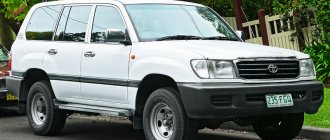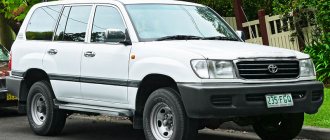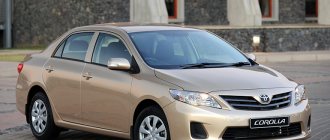general information
In Russia, sales of the RAV4 SUV speak for themselves. For example, in 2015, the share of these cars in the domestic market amounted to 7.4 percent in less than nine months. This high figure is largely due to excellent equipment, high dynamic and performance indicators, as well as the presence of a limited number of standard versions of the engine and gearbox assembly. This makes it possible to focus on other options when choosing, without being distracted by which of the ten options is preferable. In practice, the car in question is equipped with everything necessary with a minimum of unnecessary options, which helps keep the already considerable price tag down.
Let's study in more detail the parameters and features of the Elegance configuration. This diesel belongs to the line with the “Premium” set. Only “Prestige” and “Prestige Safety” are more expensive than it. The “stuffing” includes 4x4 all-wheel drive, a 2.2-liter diesel power unit, a reliable chain drive and an automatic transmission with six modes.
Possible problems and troubles with the Rav 4 diesel engine
Toyota Rav 4 diesel engine problems:
- Carbon deposits in the key elements of the Rav 4 2.2 engine due to increased oil consumption. Most often, soot settles in the EGR channel; clean it regularly. Every 30 thousand km.
- Quite often the cylinder head gasket is destroyed , which can lead to failure of the entire block.
- The fuel circuit is characterized by the following malfunctions: failure of the internal elements of the injection pump ; problems with booster and main injectors .
- There is a violation of the tightness of the oil pan, pump and timing chain cover.
- The weak point is the elements that are responsible for reducing the level of toxicity . These include the converter, differential pressure sensor, EGR valve, throttle actuator and exhaust fuel injectors.
Malfunctions in the operation of the particulate filter element regeneration unit caused by software failures in the control unit.
Exterior
Like most of the latest modifications of other lines, the designers decided to give the appearance of the RAV4 diesel engine maximum sportiness. The configurations do not particularly stand out from each other; traditional colors and familiar 17-inch alloy wheels are used. In general, the exterior of the car in question is not one of the main selection criteria, since it is almost identical in any price segment.
The technical parameters of the machines also do not differ much. More expensive versions simply have the maximum “filling”, which you can do without, saving a couple of hundred thousand rubles. Appearance is strictly for everyone; it can be attributed to both the pros and cons of an SUV. This largely depends on the personal preferences of the user.
Features Prestige and Exclusive
The car in the Prestige and Exclusive configurations looks more presentable and expensive. Its interior is made of leather. This not only improves aesthetics, but also allows you to maintain a neat internal appearance longer.
The seats are not just electric, but also have the ability to remember their parameters. This option significantly increases the comfort of using the car if it is driven by several people. Also, remembering the positions allows the car owner to adjust the seat depending, for example, on the traffic situation.
Vehicle in Prestige configuration
What is inside?
The Toyota RAV4 SUV (diesel) hid all its main advantages inside. The compact car is equipped with one of the most thoughtful and practical interiors in its segment. The capacity of both the passenger part and the trunk (577 liters) will give odds to many larger vehicles.
The car in question is perfect for family trips to the shops or out of town. Five people can easily fit inside the car. The second row of seats is comfortable, many consider it to be the standard of similar elements in the corresponding class. There is a lot of plastic in the interior decoration. This is practically the only complaint about the internal equipment, since the material gets scratched and dirty.
Review Style
The main advantage of the Style package is the presence of parking sensors as standard. In previous versions, its installation was possible only for a fee. The same situation applies to the navigation system. In previous trim levels it was optional and, if desired, the car owner had to pay an additional amount of about 80 thousand rubles.
In previous versions, the electric seats for the front passenger and driver were not available. In the Style filling, electrical adjustment is standard and does not require additional costs.
Appearance of RAV4 with Style filling
Multimedia system
According to reviews, the Toyota RAV4 (diesel) is equipped with a good infotainment unit, but it lags behind the most modern competitors. The system is practical and has a well-thought-out interface.
The design includes a 6.1-inch color touch display. The Bluetooth wireless function and MP3 player work well. Displaying navigation maps via satellite works perfectly, despite the outdated configuration of the device. Problems may occur with Bluetooth (echo appears during calls).
Power unit
The RAV4 diesel engine is equipped with a turbine, has a volume of 2.2 liters, and is mounted with an all-wheel drive system. On modifications with a driven front axle, gasoline analogues are installed. The engine in question is equipped with four cylinders, reliable and informative. On a five-point scale, experts give the power unit a solid “four”.
Motor parameters:
- Power indicator – 150 horsepower (110 kW).
- Torque and speed – 340 Nm/3600 rpm.
- The aggregated transmission is a six-mode automatic transmission.
- RAV4 diesel consumption ranges from 8 liters in the urban cycle to 5.9 l/100 km on a suburban highway.
The operation of the motor is accompanied by moderate noise, not exceeding reasonable vibration and sound limits. During testing, the engine shows high technical and operational characteristics and is focused on a wide speed range. The dynamics pick up quickly and confidently; in the interval from 60 to 80 km/h there is a sharp acceleration, which is quite expected.
Cylinder block
Aluminum alloy is used to manufacture the in-line four-cylinder engine of the Toyota Rav 4 diesel . The cylinder diameter is 86 mm. To ensure an appropriate level of heat dissipation, the unit is made with an open cooling jacket. Thin-walled liners are made from cast iron , the outer surface of which has special irregularities. The sleeves are installed using the fusion method, which promotes high adhesion to the block.
Cylinder block 2AD
The pistons are light alloy with a protective layer of polymer on the skirt, the stroke of which is 96 mm. The piston has a non-resistive insert, which is located directly in the upper installation groove under the compression ring. The connection to the connecting rods is made with floating pins. To ensure cooling of the combustion chamber, a channel is provided in the block. The balancing mechanism is driven by a gear transmission through the crankshaft. The diesel engine has a cast iron crankcase with cast-in crankshaft main bearing caps.
The manufacturer does not provide for a major overhaul of the unit, but in Russia Rav 4 diesel engines are lined.
The balancing mechanism is driven by a gear
Turbine Toyota Rav 4 diesel
Toyota Rav 4 diesel is equipped with a 1st generation turbine with liquid cooling and vacuum drive. The turbocharger uses guide vane geometry, which ensures the operation of the 2AD-FHV diesel engine in various modes. When the engine operates at a reduced crankshaft speed, the pneumatic actuator acts on the control ring and covers the turbine blades. The movement of the blades is carried out due to hinges. When the turbine blades close, the torque increases due to an increase in boost pressure.
Motor lubrication
When a diesel engine operates at high speeds, the turbine blades will open. Which reduces the level of output resistance by maintaining optimal boost pressure.
This turbine design provides:
- regulation and maintenance of optimal boost pressure in accordance with the crankshaft speed;
- no bypass valve.
Dismountable oil filter with replaceable cartridge
Flaws
The power unit of the car in question can hardly be accused of being utilitarian. However, the interior of the car, especially at top speeds, suffers quite noticeably from excessive noise levels. The quality and scope of the insulating materials clearly leaves much to be desired. When moving rapidly, a whole orchestra of noise sounds in the cabin, to which you don’t even need to listen. There are sounds from touching the road surface, and the whistle of the wind, as well as the guttural sound of the engine in time. At low speeds, this problem practically does not bother the driver and passengers, but it makes you think about improving the equipment.
Ski luggage racks on the roof of the Toyota RAV4 (diesel) showed themselves in the most negative way during testing. The element created prolonged whistling sounds even when moving at a speed not exceeding 60 km/h. As the dynamics increase, the noise only increases. Therefore, it is better not to install a trunk unless absolutely necessary, so as not to injure your ears and hearing organs of people in the cabin.
A little test drive
When road testing cars, they usually pay attention to the presence or absence of comfort. If you do not take into account the noise mentioned above, you feel quite comfortable behind the wheel of the RAV4 2.2 diesel.
However, like any technology, there are shortcomings. For example, the stiffness of the suspension is well felt. Potholes, bumps and uneven roads cause shocks and blows to the back or other parts of the body. There was a suspicion that excessive tire pressure was to blame, but repeated checks showed the norm.
From this it follows that the suspension unit of this crossover is initially rigid, and with 18-inch wheels and low-profile tires the situation will only worsen. The car's handling is also far from sporty. There is noticeable body roll on tight turns. Driving off-road does not evoke any special emotions. True, the test was only on a rolled primer, since they decided not to drive the car onto hard obstacles in this test drive.
Large trunk is a big plus
The capacity should be discussed separately. It's no secret that buyers of family cars pay great attention to trunk volume. The RAV 4 crossover has been in production for 25 years. The management of the concern, starting with the production of a mini-crossover, by 2005 finally decided on an SUV-class crossover. All this time, the design team has been experimenting with the capacity parameters of the cargo compartment.
1st generation (1994-2000)
The XA10 platform debuted in the United States in the form factor of a three-door mini-crossover with a very small luggage compartment volume:
- body SXA10 and SXA15 – 175, 263 and 266 liters;
- body SXA11 and SXA16 – 759 and 889 liters. These are already five-door versions, in which capacity has increased significantly.
Miniature car 1995
In 1995, the short-wheelbase version with a removable roof and the smallest trunk - 175 liters - rolled off the production line for the first time. In 1997, the cars were restyled for the first time. In Europe and Russia, RAV4 models with the SXA11 body were sold with a trunk volume of 409 liters. For such a significant increase in volumetric indicators, the designers had to lengthen the car by 42 cm. Half of this was in the wheelbase, and the other half in the trunk.
2nd generation (2000-2005)
In the new century, the RAV4's small trunk failed the popularity test and underwent significant changes in the direction of increasing volume. For the American continent, on the CA20W platform, only the body brands changed over the course of five years, the capacity remained the same. In five-door ACA bodies 21, 23, 26 and 28 numbers it amounted to 827 hp.
Curved fifth door of the second generation RAV4
In the Russian Federation, at the beginning of the new century, three-door mini-crossovers of the first generation were presented. The minimum trunk volume on the ACA 20 body was 150 liters, the maximum (five-door ACA 21) was 400 liters. The luggage compartments of all second-generation cars are characterized by a not very high loading height. But the designers equipped them with several side pockets for storing small-sized cargo.
3rd generation (2005-2013)
Since 2005, Toyota engineers began to actively experiment with the number of seats. The CA30W body was produced in five- and seven-seater versions. For front-wheel drive versions - ACA38 and GCA38, for all-wheel drive - ACA33 and GCA33. The trunk of the seven-seater RAV4 for the USA has “lost weight” to 348 liters. The five-seater car received a transport compartment that was unique in volume – 1031 liters.
3rd generation trunk
Third generation cars also came to Russia:
- 2005 – body ACA30 and ACA31, 586 l.;
- 2008 – body ACA33, 410 l.;
- 2010 – body ZSA30 and ZSA35, 410 and 540 hp.
European cars on the XA30 platform with a long wheelbase received a trunk volume of 450 liters.
The main feature of the third generation cars was the unification of the luggage compartment.
On almost all subsequent models the volume was half a cubic meter.
Equipment and prices
For comparison, below are the differences between all the main configurations of the Toyota RAV4 car with estimated prices:
- “Standard” is a version with front-wheel drive and an electronic copy of the cross-axle differential. The set of options includes air conditioning, washer, headlights, audio system, immobilizer, spare wheel. In addition, for one million rubles, users receive LED DRLs, seven airbags, heated seats, ABS, EBD and EBS systems, central locking and full power accessories. The car on 17-inch wheels is driven by a two-liter engine with a manual gearbox.
- Option "Standard Plus". A crossover with a front drive axle, in addition to the above-mentioned option, is equipped with a CVT, parking sensors and a leather-wrapped steering wheel. Estimated price – from 1.05 million rubles.
- Series "Comfort". It should be noted here that there is a manual transmission, a 2.0-liter engine, climate control, various sensors, a stability control system, and an updated multimedia system. The version is available at a price of 1.18 million rubles.
- “Comfort-plus” has the same as the previous option. In addition, there is a CVT, xenon light elements, and a descent assist system. Price – from 1.24 million rubles.
- "Elegance". This version was discussed in detail in the review. The 2.2-liter diesel engine is coupled with a six-speed automatic transmission. Among the interesting options: folding heated mirrors, keyless entry, leather interior, push-button start of the power unit, additional heater. Cost – about 1.35 million rubles.
- "Elegance Plus". On this version, the engine has a volume of 2.5 liters, the price increases by about 100 thousand rubles.
- "Prestige". The package includes all-wheel drive, automatic transmission with CVT, 2.2-liter diesel engine, navigation system adapted for the Russian language, blind spot monitoring, voice control. The cost of the model will be from 1.5 million rubles.
- "Prestige Plus" The engine size (2.5 l) differs from the above configuration.
Main differences of Standard+
The difference between the Standard+ configuration is the presence of a variator instead of a manual gearbox. As a result, the dynamics of the car sagged slightly, but efficiency increased.
The advantage of the Standard+ package is climate control, which comes instead of air conditioning. All-wheel drive vehicles also have hill descent control.
Reviews of the Toyota RAV4 2.2 diesel engine
In their responses, the owners of this SUV note objective advantages. Among them:
- Spacious interior and trunk.
- Reliability and practicality inherent in Japanese cars.
- Updated exterior (here the prevailing role is played by a matter of taste and personal preference).
- A good indicator of maneuverability and controllability.
- Decent ground clearance, allowing you to overcome serious off-road conditions.
- High quality braking system.
- Powerful motor.
Negative points in their reviews of the RAV4 (diesel) include an outdated infotainment system and a stiff suspension, which is not entirely suitable for a family SUV, especially when driving around the city. Some users point out flaws in the external contours of the car.











